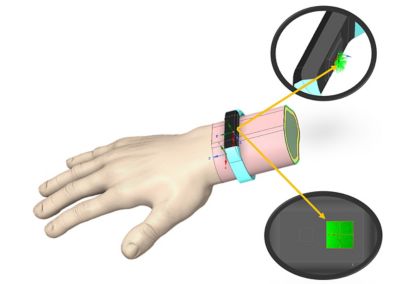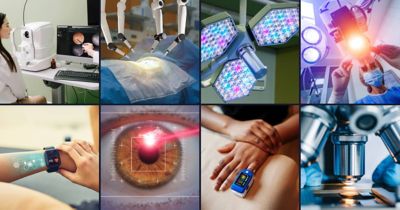-
-
Access Free Student Software
Ansys empowers the next generation of engineers
Students get free access to world-class simulation software.
-
Connect with Ansys Now!
Design your future
Connect with Ansys to explore how simulation can power your next breakthrough.
Countries & Regions
Free Trials
Products & Services
Learn
About
Back
Products & Services
Back
Learn
Ansys empowers the next generation of engineers
Students get free access to world-class simulation software.
Back
About
Design your future
Connect with Ansys to explore how simulation can power your next breakthrough.
Free Trials

The intersection of optics, wearable health monitors, and immersive technologies like augmented reality (AR) and virtual reality (VR) is ushering in a new era of innovation in consumer electronics. In recent years, wearable health monitors have evolved from basic step counters into sophisticated devices capable of tracking heart rate, oxygen saturation, and blood pressure. These devices are increasingly becoming indispensable in our daily lives, empowering users to take control of their health and providing critical data for medical professionals.
The Rise of Wearable Health Monitors
The global market for wearable health monitors is projected to grow significantly, driven by advancements in sensor technology, miniaturization, and the integration of artificial intelligence (AI). However, with this growth comes the challenge of designing compact, efficient, and accurate devices that deliver seamless user experiences — a challenge in which Ansys Optics excels.
From tracking vital health metrics to creating immersive healthcare experiences, the Ansys Optics product collection is at the forefront of enabling cutting-edge solutions that blend advanced simulation capabilities with real-world applications.
The Role of Ansys Optics in Wearable Devices
Optical systems are at the heart of many wearable health monitors. From photoplethysmography (PPG) sensors that measure blood flow to advanced imaging systems, precision in optical design is crucial to achieving reliable performance. Ansys Optics offers powerful simulation tools that enable engineers to design, optimize, and validate these optical systems with unparalleled accuracy.
Key Advantages of Ansys Optics for Wearable Health Monitors
- Miniaturization: Ansys Optics helps engineers design compact optical systems that fit within the sleek and lightweight form factors demanded by wearable devices.
- Efficiency: By simulating light propagation, scattering, and absorption, engineers can optimize the energy efficiency of optical sensors, extending battery life.
- Accuracy: With advanced ray tracing and wave optics simulation, Ansys ensures that wearable devices deliver precise and reliable measurements under varying conditions.
- Thermal management: Optical systems often generate heat, which can impact both performance and user comfort. Ansys’ multiphysics simulation capabilities address thermal challenges, ensuring optimal functionality.

Simulation tools enable engineers to design, optimize, and wearable optical systems.
Bridging Wearable Health and AR/VR
The convergence of wearable health monitors and AR/VR technologies opens groundbreaking healthcare and wellness possibilities. Imagine a fitness tracker that not only monitors your vitals but also projects personalized workout guidance into your AR glasses. Or consider VR applications that provide immersive rehabilitation programs, tailored to real-time biometric data collected by wearable devices.
Ansys Optics plays a pivotal role in realizing these possibilities. For instance, AR/VR systems rely on traditional optical components, such as lenses and mirrors, and ones like holographic optical elements (HOEs) and metasurfaces to deliver seamless visuals. Ansys’ simulation tools enable designers to optimize these components for clarity, brightness, and durability, ensuring an exceptional user experience. Additionally, wearable health monitors integrated with AR/VR systems require robust optical connectivity, which Ansys Optics enables through precise modelling and validation.
Driving Innovation in Consumer Electronics
The broader consumer electronics market is also benefiting from advancements in optical simulation. Devices like smartwatches, fitness bands, and AR glasses are no longer standalone gadgets. Instead, they are interconnected components of a larger ecosystem designed to enhance user convenience and health.
Ansys Optics empowers consumer electronics companies to innovate faster and reduce time to market by providing comprehensive simulation solutions. By eliminating the need for costly physical prototypes and enabling virtual testing, Ansys enables engineers to explore creative designs and iterate efficiently.

A Future of Possibilities in Wearable Health Monitors
As wearable health monitors continue to integrate with AR/VR technologies and consumer electronics, the possibilities for innovation are virtually limitless. From preventive healthcare to personalized fitness coaching and immersive therapeutic experiences, these devices will redefine how we engage with our health and wellness.
With Ansys Optics leading the charge in optical simulation and optimization, the future of wearable technology promises to be brighter, more efficient, and more impactful than ever before. By bridging the gap between advanced optical engineering and real-world applications, Ansys is enabling engineers to design the next generation of smart, connected devices that enhance lives and empower consumers worldwide.
Discover how Ansys Optics can elevate your wearable health monitor designs and help you unlock the full potential of AR/VR in consumer electronics. Visit the Ansys Optics product collection page to learn more.
The Advantage Blog
The Ansys Advantage blog, featuring contributions from Ansys and other technology experts, keeps you updated on how Ansys simulation is powering innovation that drives human advancement.


